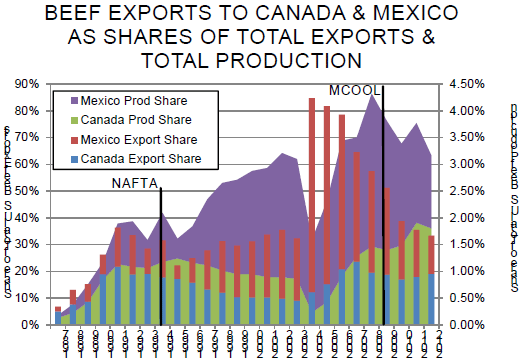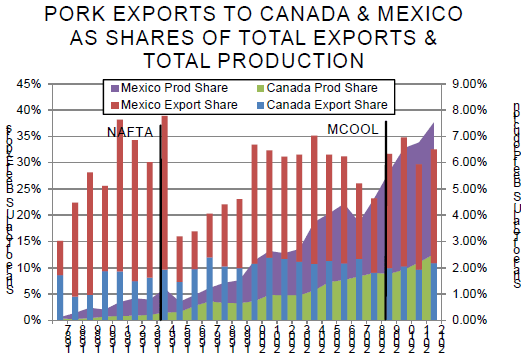



CME: USDA to Start Enforcement of Red Meat Rule
US - We are now less than three weeks away from the 23 November end of the six month “education period“ allowed by USDA regarding the revised mandatory country-of-origin labeling rule that was finalized in May, write Steve Meyer and Len Steiner.On 23 November, USDA will begin enforcing the rule which says that most muscle cuts of beef, pork and lamb sold through retail outlets must carry a label detailing where various production activities for the cut took place. The labels will specify where the animal from which the cut comes was born, raised and slaughtered. Since there is practically no product from animals that are born and/or raised in the US and then slaughtered in either Canada or Mexico, the new rule will require one of three labels on US muscle meat cuts:
- Born in Country X, Raised and Slaughtered in the US.
- Born and Raised in Country X, Slaughtered in the US.
- Born, Raised and Slaughtered in the US.
The last of those labels is important to US retailers (primarily those buying imported beef and lamb) but is of no consequence to US packers. The first two generally correspond to what are called Label A and Label B under the 2008 revision of the MCOOL law and the subsequent MCOOL rule enacted in 2009. Importantly, Label B under that rule allowed some comingling of product, a fact that provided some flexibility for US packers to fill out slaughter days with Canadian-origin animals thus reducing some of the cost impacts that will now be incurred due to the more specific an limiting labels.
The real problem, though lies in the fact that we do not yet know if this “fix” will pass muster with the World Trade Organization. That body, in response to the challenges of Canada and Mexico, held that the old labeling regime was a violation of our trade agreements. There were a number of reasons for that finding but one in particular pointed to MCOOL requiring a lot of recordkeeping and information gathering but not providing all of that information to consumers. No one that we know thinks that finding was the most critical aspect of the WTO decision but it is the one that USDA chose to address with the new, production-phase-specific labeling requirement. Could this be related to the new label being exactly what the groups that supported MCOOL and are, in general, more politically aligned with the Obama administration had in mind all along? Of course not. A pox on us for being so devious.
There is much at stake, however. The charts at right show the shares of total US exports and total US production accounted for by Canada and Mexico since 1987. Note that the charts are cumulative. In the top chart, the purple area representing the share of total US production that is exported to Mexico (1.36 per cent in ‘12) is stacked on top of the share of total US production exported to Canada (1.8 per cent in ‘12). The sum (3.16 per cent) is read off the right-hand axis. The bars which represent the shares of total U.S exports are also cumulative but read off the left-hand axis.


Canada has already published a list of US export items that it will consider for retaliatory tariffs if the WTO finds, as we expect, that the new rule does not fulfill our trade agreement obligations. The list is far-ranging and attracting quite a lot of attention — and pressure on the Farm Bill conferees — from interests in and out of agriculture. But the magnitude of the impact on beef and pork is clear. If tariffs are imposed, we will not lose all of the 3.2 per cent of beef production and 7.5 per cent or pork production exported in 2012. But the roughly 3:1 price:quantity impact that any loss will cause will be applied to 100 per cent of our beef and pork production. Can anyone afford such a loss?








